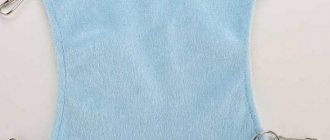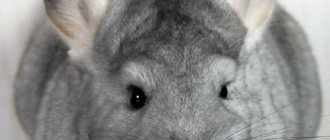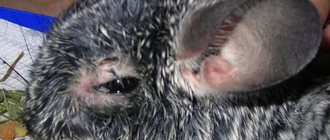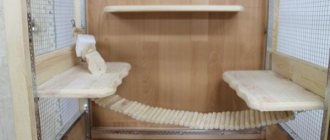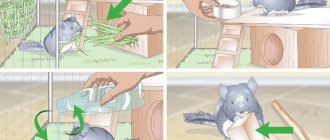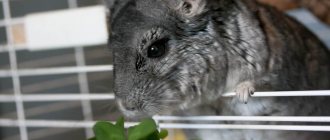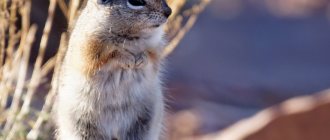Chinchillas are active, positive and very funny animals. Many breeders, in order to diversify their pet’s days, buy and install special toys in their cages. In addition to toys, furry pets require accessories such as a carrier and a fur brush. Some owners also buy harnesses and leashes, but there are many dangers associated with their use.
Types of toys for chinchillas
Toys for furry rodents are made from different materials, but they all have one common requirement - safety. Therefore, you should not buy and use toys from:
- Plastics,
- Rubbers,
- Plexiglas,
- Cardboard, foam or paper,
- Any material with a high content of gels, paints or varnishes,
- Any material containing cement or lime.
Most often, toys for animals are made from ceramics, wood, stone, metal and plant fibers.
Wooden toys must not contain any traces of paint and be made from approved types of wood:
- Beech,
- And you,
- Poplars,
- Apple trees,
- Cherries,
- Birches.
Wooden toys can be either static - attached to the floor or walls, or free-lying. All kinds of swings and ladders, houses, shelves, labyrinths and ladders are most often made from wood.
When choosing a ceramic toy, you should carefully inspect it for the absence of sharp corners or protrusions. You can use flower pots, drainage pipes of suitable diameter and other pottery items.
Stone toys are designed to grind down constantly growing teeth, which means they should not contain dangerous inclusions. Most often, stone toys are stones for grinding teeth. Sometimes they are shaped like a castle, a fruit or a vegetable.
All kinds of ropes, hammocks and ladders, ropes, bedding, baskets and bowls are made from plant fibers. The main condition is that the fabric must not be bleached or dyed.
Metal toys are represented by various running wheels.
Static toys
There are various kinds of “exercise machines” for chinchillas - the furry ones must keep themselves in good physical shape! To do this, shelves, tunnels, sticks and ladders are installed.
Shelves are the simplest and most universal solution. By the way, rodents have very strong hind legs, and they can jump to great heights. Therefore, do not hesitate to raise the shelves to a decent height: most likely, your pet can easily cover a distance of half a meter to a meter. The shelves are used by the animals to sharpen their teeth. You can buy ready-made shelves in the store or make them yourself (you just need to sand the wood thoroughly so that your pet doesn’t get hurt).
Chinchillas love to run through tunnels. Probably, pipes of different diameters remind them of burrows - narrow, long passages in the ground. The longer the tunnel, the better. The material can be wood or plastic (including translucent - for visual control of the animal).
You can put an ordinary wooden stick in the cage - the baby will chew and roll it, try to jump over, etc. By placing several sticks in a row, you will build an even more interesting “attraction” - a ladder.
Well, a hammock is suitable for relaxation. Chinchillas happily swing on the stretched dense fabric. However, the hammock can also be plastic - including one or two tiers. Again, you can sew a fabric hammock with your own hands.
DIY pet toy
Toys can be not only purchased. Chinchillas are quite smart animals and adapt a variety of objects for their games. Even a nut shell can become a furry pet's favorite toy. Some breeders prefer to make toys for chinchillas with their own hands. For the most popular option you will need:
- Metal chain from a hardware store,
- Several metal key rings,
- Branches of any permitted tree,
- Drill,
- Saw.
The twigs must be washed well and dried, preferably in the oven. The branches are sawn into bars and rounds. A hole is drilled in each of them, with a diameter equal to the diameter of the chain. A chain is threaded through all the branches, and key rings are attached to its ends. They are very convenient for hanging a ready-made toy on the walls of the cage. The number of branches and the length of the chain depends only on the wishes of the breeder and the size of the cage!
Stuffed Toys
But the use of soft toys is a very controversial issue. Some breeders claim that their pets play with plush toys and even sleep cuddled with them. However, most have a negative experience: the toy quickly breaks into pieces, the filler and other parts end up in the pet’s stomach and cause poisoning of varying severity, intestinal obstruction and even death. If you wish, you can try giving a soft toy to your pet and see his reaction. It is likely that the animal will make friends with the toy. However, this does not mean that after some time the chinchilla’s plush friend will not be torn to pieces.
What toys do chinchillas like?
Today you can buy a large number of different toys in stores. However, the chinchilla itself must choose the appropriate specimen. To do this, the owner should find out the pet's preferences. This can be checked using a small ball. Some animals run after him if you push him. Others are indifferent to him. When buying a toy, you need to monitor the animal’s reaction. For chinchillas, toys are an integral part of a happy and long life.
Chinchilla carrier
When choosing a carrier, you should focus on what it will be used for. If for a short trip - to the doctor or to the country, then it is better to choose a small box that can be easily placed in a bag and insulated if necessary. It is better not to buy a carrier that is too large - the animal can easily be injured. However, the box should not be too cramped - cramped space will lead to stuffiness. There is no need to try to find one carrier for two or more animals: transportation is always carried out in individual boxes.
The most convenient and practical carrying option is a plastic container.
One of the most popular manufacturers of pet products, Ferplast, has in its product line a carrier for chinchillas with dimensions of 36 by 26 by 23 cm. This type of transport box, at its low cost, has enough holes for ventilation, is reliable and durable. An additional plus is that the bottom of the side is solid, which means the filler will not be scattered throughout the bag.
During the cold season, it is recommended to place the carrier in a bag. You can use any sports bag of a suitable size, or a special one for transporting animals.
Before placing the animal in the carrier, the bottom must be covered with bedding. Typically, sand for chinchilla bathing, sawdust or wood granules serve as bedding. Sand is very convenient, but it is not recommended to use it if your pet is going to a show. Grains of sand that get on the fur will distort the natural color of the pet. During the winter months, the use of sand is also controversial during long-term transportation: sand does not retain heat well.
In winter, it is recommended to insulate the carrier with hay, as well as put some of your favorite treat - this will help cope with stress.
Moving toys
Movable toys help your pet stay in shape. Chinchillas love hanging structures. They stagger, rattle and ring. The animal can swing them in different directions. With the help of them he can grind down his teeth. Rodents prefer to play at night, so moving toys have a downside. Not every owner is ready to tolerate loud noises at night. Therefore, they must be removed so that the pet plays only during the day.
walking ball
With the help of such an item, the animal will be able to walk around the apartment without fear of being crushed. Thanks to this, furniture and wires will remain safe: the animal will not be able to reach them. Durable transparent plastic is used as the material for the ball. It must have holes for ventilation. The design consists of two hemispheres that unwind or close. Before purchasing, you should pay attention to the disadvantages of the toy. Small holes do not provide proper ventilation of the air inside the ball. Leaving your pet for a long time can lead to suffocation. You should not leave the animal in such a toy unattended.
Hanging toys
When they first appeared, hanging toys were used for birds. Over time, they began to be offered to rodents. Animals like shaking structures that make a ringing sound. Excessive noise is the main disadvantage of such toys. So that the pet and the owner can take a break from the ringing, it is necessary to remove the hanging object from the cage at night.
Spinning wheel
The wheel is very popular among rodents. A chinchilla can run for several hours, skipping sleep time. Wood, metal, plastic and aluminum are used to make wheels. A metal product is considered the most durable and durable. However, there are dangers when using it:
- When keeping several animals in one cage, the metal wheel stand can pose a danger to them. While one animal runs, another can seriously damage its paws.
- Your pet may get a claw or fur caught in the mesh used as a wheel cover.
To ensure safety, the exercise machine is covered with thick fabric. The plastic version does not have a stand, so it is less dangerous. The wheel is attached to the wall of the cage. The maximum diameter size is 32 cm. It is not suitable for many animals. Therefore, it is better to buy a wooden or aluminum wheel. Their diameters are much larger and can reach up to 40 cm. A wooden product cannot be bought at a regular pet store. It can be made to order, or made by yourself. The aluminum trainer is not so popular due to its high cost. It is due to delivery from abroad.
Making a spinning wheel at home
To make a rotating wheel with your own hands, you will have to put in a lot of effort. Proficiency in wood or metal cutting will be a plus.
Materials and tools needed for the wheel:
- a tool for cutting metal, for example, a grinder;
- fine-grained sandpaper;
- aluminum pan - diameter not less than 40 cm;
- nut and bolt.
After purchasing all the necessary items, we begin making the simulator:
- The first step is to saw off the excess edge of the pan. Its height should be about 15 cm. To avoid injury to the pet, the edges are sanded with sandpaper. A hole is drilled in the center of the bottom of the pan.
- The future product is placed inside the cage. Using a bolt, the workpiece is attached to the rods. From the outside, you need to tighten the nut so that the wheel rotates freely.
A homemade exercise machine is much safer than a purchased one. The finished product should be checked for functionality. If the wheel does not spin, the nut must be loosened.
Clothing, leashes and harnesses for chinchillas
The accessories for chinchillas presented in stores today are so diverse that they confuse breeders. The most controversial product is the leash with harness. It is strictly forbidden to walk chinchillas on the street. And there are several reasons for this:
- Chinchilla fur is easily damaged by any harness or collar,
- Chinchillas don't walk - they move by jumping. A collar can break your spine, a harness can break your ribs,
- There are quite a lot of dangerous bacteria, microbes, fungi,
- A sudden change of environment, new smells and sounds, bright light - all this will lead to very strong stress and can provoke a heart attack.
- A chinchilla is usually walked at home, but for home walks a harness and leash are not needed.
- In the same way, leashes and harnesses are not needed for exhibitions - the animal is placed from the carrier into the exhibition box.
Products for chinchillas include a variety of clothes: vests, jackets, shorts, overalls and dresses. There is no need to talk about the actual use of such accessories: you cannot leave an animal in clothes in a cage - in a few minutes the pet will chew everything it can reach and also get poisoned by the dyed fabric. At exhibitions, animals also do not need additional decorations. The downside is that the chinchilla is a freedom-loving animal, and it can be very difficult to persuade the animal to wear clothing that restricts movement.
It is also worth remembering that the animal’s fur is quite dense and warm, which means you can get heat stroke from wearing clothes, especially in the summer months.
Everything has its time
Before offering toys to your chinchilla, create a comfortable environment for the animal. The animal must get used to the environment and its owners. If you are going to let your pet out of the cage, you need to clean the room: there should be nothing unnecessary on the floor, much less dangerous for the rodent.
To begin with, you should stay away from the chinchilla - give him the opportunity to explore the new space on his own. Under no circumstances should you frighten the animal with loud sounds or sudden movements; you should not turn the lights on or off. It is also very important for the animal that the path home (to the cage) always remains open.
When the rodent gets used to the environment and gets a little “bored”, it will begin to bite and pinch everything in its path. At this time, you can offer him new toys. Just be prepared for the fact that the animal will remain indifferent to the “gift” - it will decide for itself what it likes to play and what it doesn’t.
What toys are suitable for chinchillas:
- moving;
- static (interior);
- from scrap materials.
As for the cage, it should also have toys - this is a prerequisite. The fact is that an active animal needs to constantly expend energy. And if he doesn’t find something to do, he will start chewing his fur out of boredom. Alas, these small animals are also susceptible to bad habits (the problem is partly solved by chinchilla training).
Fur care
But what is really needed is a good brush to care for the animal’s thick fur. They get used to using a comb gradually. Usually chinchillas like this procedure and do not express dissatisfaction. Regular brushing will help avoid many problems with skin and fur: dermatitis, fungal diseases, infection with skin parasites. Also, using a comb before the exhibition, you can give your pet a more neat appearance.
However, finding a special comb for a chinchilla in Russia is not so easy: the product is quite rare and expensive.
It differs from ordinary brushes for animals by thinner, sharper and more frequent teeth, which can be compared to needles from a sewing machine. This brush combs out the animal’s thick fur well. You have a better chance of purchasing a special comb if you go to a large nursery. Typically, large breeders bring specialized products from European farms or work directly with manufacturers of products specifically for chinchillas. If this is not possible or the price of the product is too high, you can choose a brush for a cat or dog with the longest and most frequent teeth.
How to make a toy from scrap materials
You can surprise your pet with toys made with your own hands.
Sometimes you don’t even have to do anything to entertain the animal, you can give it a rustling object that it will chew or roll. For example, put a walnut in a cage; it will entertain the rodent for a long time with its rumble.
Various wooden sticks or balls will also work. They need to be strung on a rope or thick thread and hung in a cage. Do not rush to throw away the wooden thread spool; it is better to place it in a cage. This simple toy will be an excellent teeth sharpener.
Chinchillas are very similar in character to children - they are energetic, tireless, cunning, inquisitive and love to play.
Playing together with a chinchilla will not only brighten up your leisure time, but will also help you find contact with your pet, charge you with positivity and give you new impressions. And for a chinchilla they can be a real adventure. We have selected several scenarios for playing with a chinchilla:
Sherlock Holmes
Let your chinchilla show his investigative skills and be a bit of a real detective, solving fascinating puzzles and puzzles.
To play, we will need a piece of treat and intelligent wooden toys for rodents. Prepare a play area, hide your chinchilla’s favorite treat among the toys and give her the opportunity to find it. A more difficult option is to hide the treat inside the toy to allow the chinchilla not only to find it, but also to figure out a way to get it.
Everest
All chinchillas love to explore new spaces and conquer new heights. On the chinchilla's play area, build a mountain of boxes. Thick boxes from household appliances and shoes are suitable for these purposes. Place your chinchilla's favorite treat at the very top of the mountain and let her get it.
Quest
Quests are now quite popular entertainment. Make an escape room for your pet too. Place ping pong balls, boxes, crates, and pillows around the room. Release the chinchilla and leave the room ajar. Place a treat or a bath with sand behind the door of the room and watch how quickly your pet orients itself in the new space and reaches its goal.
King Kong
Everything is quite simple here, just let the chinchilla out of the cage and pretend that you want to catch it. But it is important to pretend, and not to catch the chinchilla. In this game, the chinchilla should remain the winner, and you can just watch it.
Happy Sands
You can play this game if you have several chinchillas. To do this, just fill a large container with a large amount of sand and let the chinchillas go for a walk next to the bathing suit. And then count which chinchilla has bathed in the sand how many times, or the duration of the bath. In this game you act as a judge. At the end of the game, the winner receives his favorite treat, and the other participant receives a consolation prize.
An important point: playing with a chinchilla should be a pleasure for both you and your pet. If the chinchilla is afraid or does not trust you, it is better to hold off on playing together. You can set up an area for joint games only in a place that is safe for the chinchilla.
How do you play with your pet? Maybe you have your own favorite games? Share your experience in the comments!
Author of the photo: Sergey Kryzhanovsky
Comments: [0 comments]
Update No comments
Dynamic toys
With the help of moving toys and devices, the animal can actively frolic outside its cage. He needs outdoor games to keep himself in good athletic shape.
Hanging toys that have the ability to shake, stagger, rattle and ring are very popular with chinchillas. They are interested in pushing them and swinging them in different directions. In some cases, animals try to find another use for such things: they grind their teeth on them.
Too noisy, rattling toys for chinchillas have one drawback. Since these animals love to play in the evening and at night, loud noises coming from the cage may not be to everyone's taste. Therefore, at night, noisy toys can be removed away from the animal. This will give both him and all household members the opportunity to relax.
